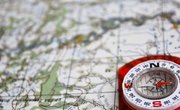Computers have revolutionized geography. Computer technology has opened new arenas of research, and allowed previously unthinkable computations. Computers streamlined record-keeping and introduced new methods in teaching geography. The spatial and pattern analyses made possible by computer technology has also facilitated interdisciplinary communication between geography and other fields of academic endeavor.
GIS
Perhaps the biggest revolution in geography has been the Geographic Information System, a computer technology that integrates cartographic mapping systems with innumerable databases. Maps can now be created that visually show patterns. Those patterns can be geophysical, sociological, demographic, hydrological, topographical, seismological, meteorological or political. These studies can be extremely detailed. For example, a GIS map integrated with local databases could show how many registered nurses by municipal district are registered to vote as Republicans and where they live.
Boundary Jumping
The versatility of GIS and other computer-based systems used by geographers has blurred the boundaries between geography and other fields of study and practical application. Geographers are now routinely employed by the military, by businesses, by social work agencies and by non-geographer co-academics. The example above about Republican nurses demonstrates how geographers, equipped with these new systems, can help in various other practical fields to conserve resources by accurately targeting efforts.
Geography, Computers and Environment
Perhaps no field has been more enriched by research using geographic computer modeling than the environmental sciences. Computers can generate multiple overlays that provide important clues about correlative factors affecting the environment. Energy production and consumption patterns can be combined with meteorological data. Land use patterns can be combined with hydrological data. Atmospheric patterns can be mapped over time to establish trends. Population densities can be correlated with temperatures. We have never had this much integrated information on the relation between humans and the planet.
A Computer-Based Science
Computers have become so critical to the practice of geography that lack of computers in many impoverished areas has led to a crisis in geography education. The changes created by computers in the very character of geography as academic discipline and practice constitute a technological phase-shift that has rendered pre-computer geography virtually obsolete. The computer has become an essential tool to “do” geography. Geography has become, for all practical purposes, a computer-based science.
Related Articles
Writer Bio
Stanley Goff began writing in 1995. He has published four books: "Hideous Dream," "Full Spectrum Disorder," "Sex & War" and "Energy War," as well as articles, commentary and monographs online. Goff has a Bachelor of Arts in English from the University of the State of New York.











